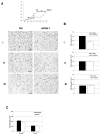Tumor galectin-1 mediates tumor growth and metastasis through regulation of T-cell apoptosis
- PMID: 21546572
- PMCID: PMC3129397
- DOI: 10.1158/0008-5472.CAN-10-4157
Tumor galectin-1 mediates tumor growth and metastasis through regulation of T-cell apoptosis
Abstract
Galectin-1 (Gal-1), a carbohydrate-binding protein whose secretion is enhanced by hypoxia, promotes tumor aggressiveness by promoting angiogenesis and T-cell apoptosis. However, the importance of tumor versus host Gal-1 in tumor progression is undefined. Here we offer evidence that implicates tumor Gal-1 and its modulation of T-cell immunity in progression. Comparing Gal-1-deficient mice as hosts for Lewis lung carcinoma cells where Gal-1 levels were preserved or knocked down, we found that tumor Gal-1 was more critical than host Gal-1 in promoting tumor growth and spontaneous metastasis. Enhanced growth and metastasis associated with Gal-1 related to its immunomodulatory function, insofar as the benefits of Gal-1 expression to Lewis lung carcinoma growth were abolished in immunodeficient mice. In contrast, angiogenesis, as assessed by microvessel density count, was similar between tumors with divergent Gal-1 levels when examined at a comparable size. Our findings establish that tumor rather than host Gal-1 is responsible for mediating tumor progression through intratumoral immunomodulation, with broad implications in developing novel targeting strategies for Gal-1 in cancer.
©2011 AACR.
Figures




References
-
- Rabinovich GA, Ilarregui JM. Conveying glycan information into T-cell homeostatic programs: a challenging role for galectin-1 in inflammatory and tumor microenvironments. Immunol Rev. 2009;230:144–59. - PubMed
-
- Liu FT, Rabinovich GA. Galectins as modulators of tumour progression. Nat Rev Cancer. 2005;5:29–41. - PubMed
-
- Rabinovich GA, Baum LG, Tinari N, et al. Galectins and their ligands: amplifiers, silencers or tuners of the inflammatory response? Trends Immunol. 2002;23:313–20. - PubMed
-
- Barondes SH, Castronovo V, Cooper DN, et al. Galectins: a family of animal beta-galactoside-binding lectins. Cell. 1994;76:597–8. - PubMed
Publication types
MeSH terms
Substances
Grants and funding
LinkOut - more resources
Full Text Sources
Other Literature Sources
Molecular Biology Databases
Research Materials

